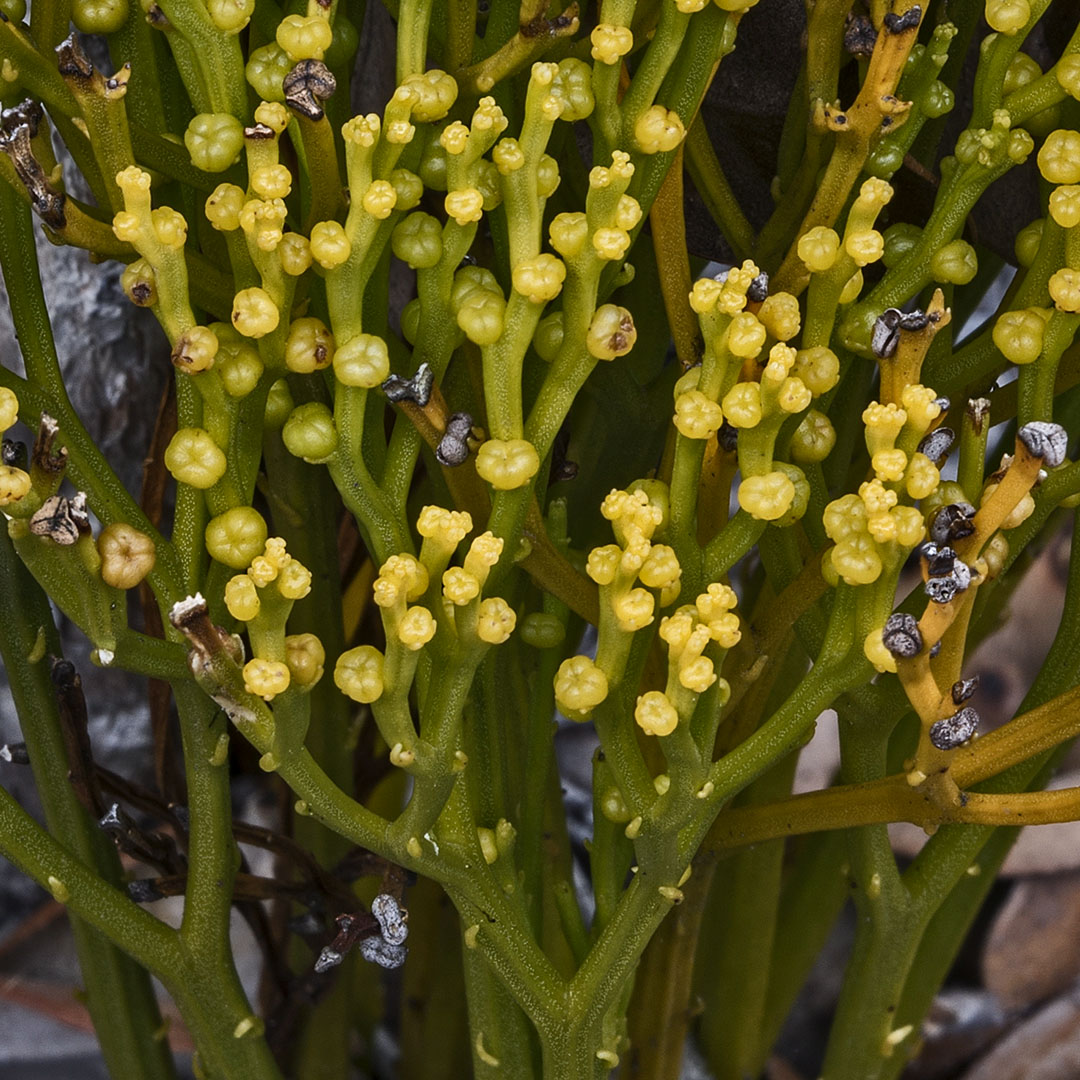Photo by Richard Droker licensed under CC BY-NC-ND 2.0
The whisk ferns (Psilotum spp.) are a peculiar group of plants. If you hang out in greenhouses long enough, you are most likely to encounter them as “weeds” growing in pots with other plants. Though they aren’t often put on display by themselves, the whisk ferns are certainly worth a closer look.
Psilotum comprises two species, the far more common Psilotum nudum and the lesser known P. complanatum. These two species will also hybridize, resulting in Psilotum × intermedium. Together, the whisk ferns make up one of only two genera in the family Psilotaceae (the other being Tmesipteris). They are strange plants to look at as there doesn’t appear to be much to them besides stems. Indeed, their peculiar morphology has earned them a fair share of taxonomic attention over the last century but before we get into that, it is a good idea to take a closer look at their anatomy.
Psilotum nudum with yellow sporagia. Photo by Mary Keim licensed under CC BY-NC-SA 2.0
What we see when we are looking at a whisk fern is the sporophyte generation. Like all sporophytes, its job is to produce the spores that will go on to make new whisk ferns. This part of the whisk fern lifecycle is pretty much all stem. Though these are in fact vascular plants, they do not produce true leaves. Instead, the branching stem takes up all of the photosynthetic work. What looks like tiny leaf-like scales are actually referred to as ‘enations.’ These structures do not contain any vascular tissue of their own. Instead, they bear a type of fused sporangia that house the spores. When mature, these will turn a bright yellow.
Underground, things aren’t much different. Whisk ferns produce a branching rhizome that is covered in hair-like projections called rhizoids. These structures not only help anchor the plant in place, they also function in a similar way to roots. Rhizoids interface with the soil environment allowing the plant to absorb nutrients and water. However, they don’t do this alone. Like so many other plants, whisk ferns partner with mycorrhizal fungi, which vastly increases the amount of surface area these plants have for absorbing what they need. In return, whisk ferns provide the fungi with carbohydrates they produce through photosynthesis. As lovely as this mutualistic relationship sounds, it actually starts off as parasitism.
A Psilotum rhizome with hair-like rhizoids. Photo by Curtis Clark licensed under CC BY-SA 3.0
When the spores find a suitable place to germinate, they will grow into the other half of the whisk fern lifecycle, the gametophyte. These resemble tiny versions of the rhizome and contain male and female reproductive organs. Living underground, the gametophytes do not photosynthesize. Instead, they completely rely on mycorrhizal fungi for all of their nutritional needs. This can go on for some time until the gametophytes are fertilized and grow a new sporophyte. Then and only then will the plant actually start giving back to the fungi that their lives depend on.
Psilotum complanatum with its flattened stems. Photo by Chad Husby licensed under CC BY-NC-ND 2.0
Because the overall form of the whisk ferns appears so “simplistic.,” many have hypothesized that the genus Psilotum is an evolutionary throwback to the early days of vascular plant evolution. On a superficial level, the whisk ferns do appear to have a lot in common with rhyniophytes, a group of plants that arose during the early Devonian, some 419 to 393 million years ago. A more detailed inspection of the anatomy of each group would reveal that there are some significant and fundamental differences between the two lineages, which I won’t go into here. Also, subsequent molecular work has shown that the whisk ferns reside quite comfortably within the fern lineage and likely represent a sister group to the order that gives us the adder’s tongue ferns (Ophioglossales). It would appear that whisk ferns more accurately represent a reduction in the more “traditional” fern form rather than a holdover from the early days of land plant evolution.
What the genus Psilotum lacks in number of species, it makes up for with its wide distribution. The whisk ferns seem to have conquered most of the tropical and subtropical landmasses on our planet. In fact, I found it incredibly difficult to discern much in the way of a native distribution for these plants. In some areas they are fairly common components of the local flora whereas in others they are considered rare or even threatened. I am sure that at least some of their expansive distribution can be attributed to human assistance as we move soils and plants around the world. To find them in nature, one must look in the cracks of rocks or on the trunks and branches of trees. Though both species can be found growing on trees, P. complanatum in particular seems to prefer an epiphytic lifestyle.
Psilotum complanatum (left) and Psilotum nudum (right) growing epiphytically. Photo by David Eickhoff licensed under CC BY 2.0
Whether you grow them on purpose, fight them as a greenhouse “weed,” or track them down in the wild, I hope you take a moment to appreciate these oddball plants. The whisk ferns are intriguing to say the least and certainly offer up a unique conversation piece for anyone curious about the botanical world. They are a genus worth admiring.






